Manga Comics Market Research, 2034
The global manga comics market size was valued at $11.2 billion in 2024, and is projected to reach $21 billion by 2034, growing at a CAGR of 6.5% from 2025 to 2034. Manga comics are a distinctive form of Japanese visual storytelling that combines detailed artwork, expressive characters, and emotionally driven narratives. Originating in Japan, manga encompasses a wide variety of genres, from action and romance to historical fiction and science fiction, often reflecting themes deeply rooted in Japanese culture, values, and societal norms. The unique visual format, characterized by exaggerated facial expressions, panel-based storytelling, and black-and-white illustration, creates an immersive experience that appeals to readers of all ages.
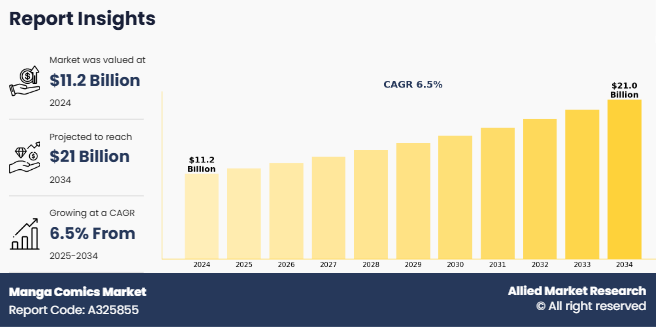
Market Dynamics
Manga, which originated in Japan, has now become a global storytelling format. With the increasing interest in anime, Japanese language, music, fashion, and food, manga has emerged as a key part of cultural exploration. Anime series adapted from manga, such as Naruto, Demon Slayer, and One Piece, have introduced millions of viewers worldwide to Japanese-style storytelling. Many fans who start with anime later become loyal readers of the original manga. Manga offers more detail, background, and character development, which makes it more appealing to dedicated fans. Cultural events, anime conventions, and fan gatherings in countries like the United States, Canada, Germany, and Brazil often include manga zones, cosplay competitions, and Japanese language workshops, further promoting the culture.
Social media has also played a big role in spreading awareness. Platforms such as TikTok, YouTube, and Instagram feature thousands of users sharing manga reviews, fan theories, and artwork, creating a strong global community. The popularity of Japanese pop culture in school clubs, universities, and local reading groups has also led to the growth of manga readership among students and young adults. Japanese publishers and licensing companies have recognized this trend and now actively promote manga in global markets. This includes expanding into non-traditional regions where interest in Japanese pop culture is growing. As Japanese media continues to shape global youth culture, the demand for manga will likely grow even stronger. The influence of Japanese entertainment and lifestyle has created a welcoming space for manga in both physical and digital forms, making this cultural movement one of the most impactful drivers of the worldwide manga comics market.
The growing interest and engagement among Gen Z and Millennial readers have become one of the most powerful drivers of the manga comics market. These younger generations are drawn to manga because of its visual storytelling, diverse characters, and emotionally rich plots. Manga offers a wide range of themes, including friendship, adventure, romance, school life, fantasy, and even complex topics like mental health, loneliness, and self-identity. These subjects reflect the thoughts, experiences, and challenges faced by modern youth. Gen Z and Millennials appreciate content that feels authentic, relatable, and expressive, and manga delivers on all these fronts, which is expected to propel the manga comics market demand. They also prefer content that is fast, mobile-friendly, and visually engaging. Most manga platforms offer reading experiences on smartphones, which matches their daily habits and technology use.
Beyond reading, young readers actively participate in manga-related communities on platforms like TikTok, Reddit, YouTube, and Instagram. They create fan art, post character discussions, share chapter summaries, and engage in theory-building, which keeps the fandom alive and growing. This peer-driven sharing encourages more people to start reading manga. Social media helps spread awareness of new titles and old classics, making the genre visible even to those who have never read a manga before. Schools and libraries have also begun to stock manga to support student interest. Some even use manga as educational tools because they engage reluctant readers. As this younger audience matures, they are expected to continue reading manga, becoming long-term consumers. Their deep emotional connection to characters and stories, combined with strong digital habits and peer influence, makes Gen Z and Millennials the core drivers of sustained manga comics market growth.
The increasing global reach of digital platforms offers a major growth opportunity for the manga comics market. With the advent of mobile apps, subscription-based services, and e-reading devices, publishers can now distribute manga to audiences in regions previously inaccessible due to physical distribution constraints. Digital distribution helps overcome language barriers as platforms offer multilingual versions and instant access, which boosts reader engagement across different demographics. Platforms like VIZ Media, Manga Plus, and Crunchyroll are now instrumental in providing same-day releases globally. This strategy helps reduce piracy by offering legal, convenient access to official content. Moreover, digital distribution significantly cuts the cost of printing, storage, and logistics, making it an attractive option for both established and indie publishers.
With more people using smartphones and internet connections expanding into rural and underserved areas, digital manga is poised to reach a larger global readership. These platforms also allow data collection on user preferences, which can be used to personalize content, recommend new series, and build loyal subscriber bases. Furthermore, digital releases often come with interactive features, such as animated panels, voiceovers, or colorized versions, which add value and attract younger readers. As internet accessibility grows in Latin America, Southeast Asia, and parts of Africa, digital manga has the potential to enter emerging markets where Japanese culture and storytelling are gaining popularity. This global digital expansion not only enables broader revenue streams but also strengthens brand recognition for Japanese publishers, creating cross-border fan communities and increasing overall demand for manga content.
One of the major restraints affecting the growth of the manga comic market is the presence of significant language and cultural barriers in international markets. While manga originated in Japan and enjoys widespread popularity across Asia, its expansion into Western and non-Asian regions faces challenges due to linguistic and cultural differences. The unique art style, character expressions, reading format (right to left), and deep-rooted Japanese references often require thoughtful localization, which is both time-consuming and costly. Publishers must invest in professional translation services, cultural adaptation, and often reformatting of artwork to make the content suitable for non-Japanese readers. These changes may lead to delays in international releases or loss of original context, thereby affecting the experience for global readers.
Segmental Overview
The manga comics market is segmented into genre, age group, reader type, distribution channel, and region. Based on genre, the market is divided into shonen, shojo, seinen, josei, kodomo, mecha, and other. Based on age group, the market is segregated into Gen Z, Millennials, and Gen X and Boomers. Based on reader type, the market is segregated into casual browsers, digital only, collectors, and others. Based on distribution channel, the market is classified into supermarkets and hypermarkets, specialty stores, bookstores, online channels, and others. By region, the market is analyzed across North America (U.S., Canada, and Mexico), Europe (France, Germany, Italy, Spain, UK, and rest of Europe), Asia-Pacific (China, Japan, India, South Korea, Australia, and rest of Asia-Pacific), and LAMEA (Brazil, Argentina, Saudi Arabia, UAE, South Africa, and Rest of LAMEA).
By Genre
By genre, shonen segment dominated the global manga comics market in 2024 and is anticipated to maintain its dominance during the forecast period. Shonen manga continues to lead in global manga sales, primarily due to its dynamic storytelling, action-focused plots, and relatable adolescent protagonists. This genre appeals widely to teenage male readers but has increasingly drawn a diverse demographic owing to its universal themes of perseverance, friendship, and self-improvement
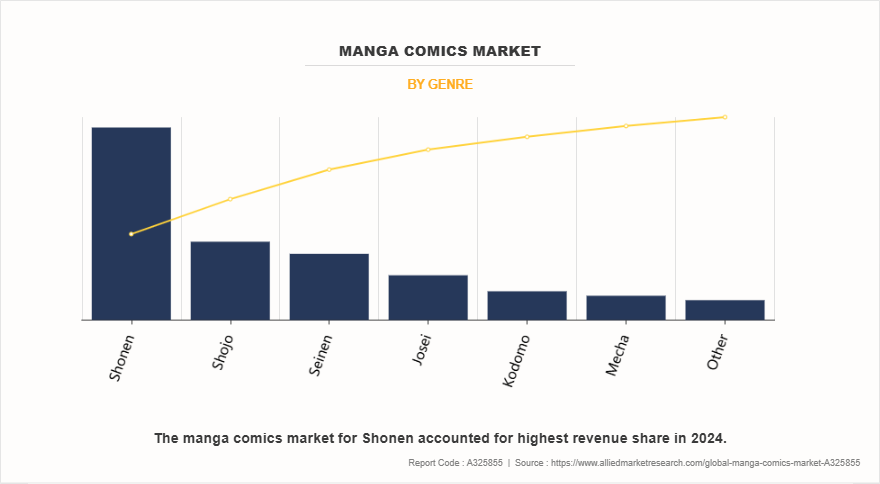
By Age Group
By age group, Gen Z segment held the major manga comics market share in 2024 and is anticipated to maintain its dominance during the forecast period. Manga continues to attract a strong following among Gen Z readers due to its dynamic storytelling and visually engaging format. These demographics favor immersive narratives, emotional depth, and diversity in themes, which align closely with many modern manga titles.
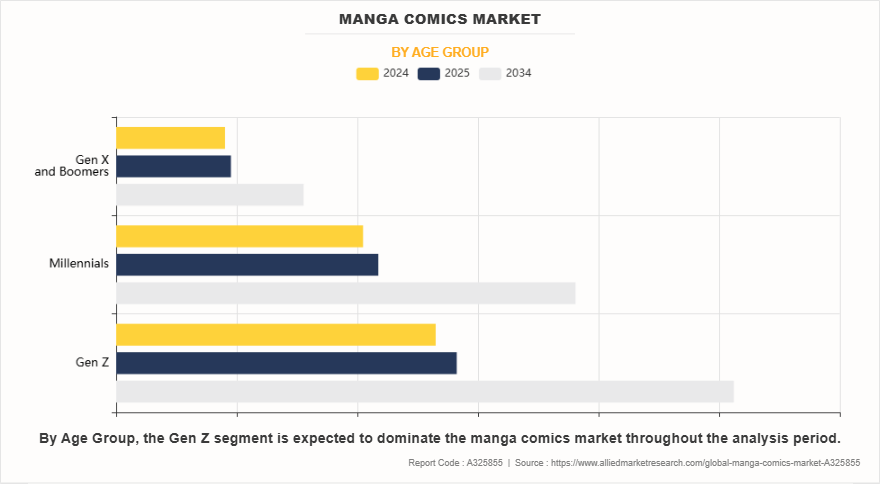
By Reader Type
By reader type, collectors segment dominated the global manga comics market in 2024 and is anticipated to maintain its dominance during the forecast period. These readers value high-quality print, original Japanese artwork, and series that hold nostalgic, artistic, or cultural significance. They are willing to pay premium prices for deluxe versions or exclusive reprints, contributing significantly to revenue through fewer but higher-value purchases.
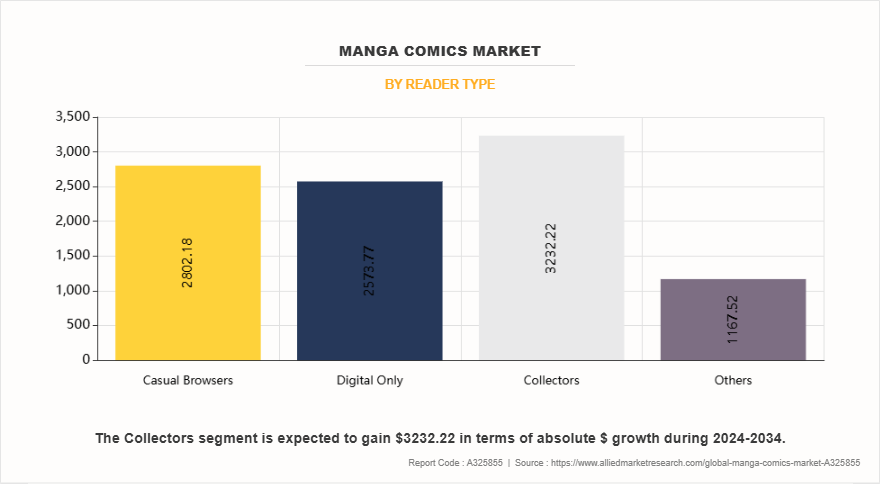
By Distribution Channel
By distribution channel, specialty stores segment dominated the global manga comics market in 2024 and is anticipated to maintain its dominance during the forecast period. Specialty stores, including comic book shops and pop culture retailers, serve as crucial distribution hubs for manga enthusiasts seeking curated collections and informed customer service. These stores offer a broader and more diverse inventory than general retail outlets, encompassing popular titles, niche genres, rare volumes, and imported editions.
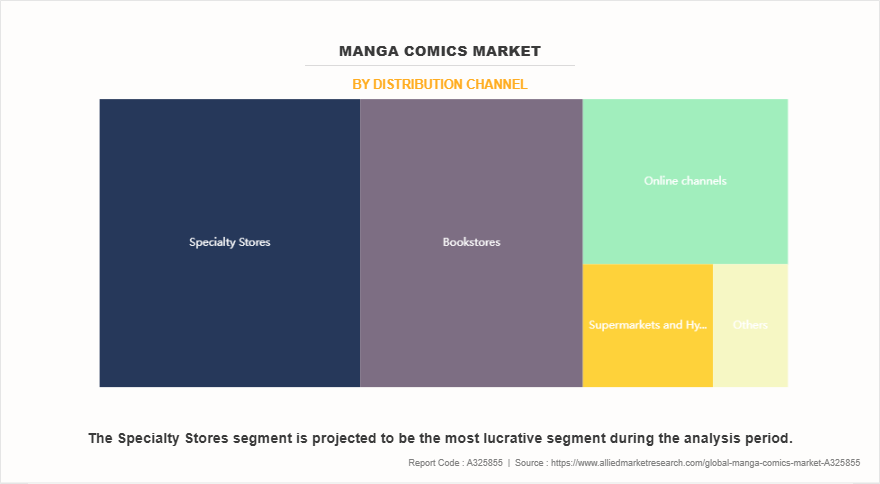
By Region
Region-wise, Asia-Pacific is anticipated to dominate the market with the largest share during the global manga comics market forecast period. Rising urbanization, increased smartphone penetration, and expanding internet access have made digital manga widely available to young readers across this region. Local manga adaptations and collaborations between Japanese publishers and Asian media houses have contributed to wider regional reach.
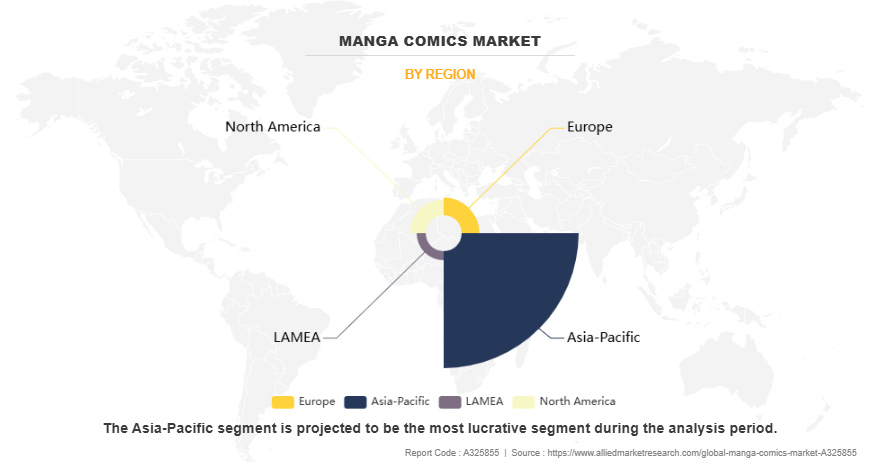
Competition Analysis
The key players operating in the global manga comics industry include Kodansha Ltd., Shogakukan Co., Ltd., Square Enix Holdings Co., Ltd., Titan Publishing Group Ltd., Shueisha, Inc., Kadokawa Corporation, Dark Horse Comics, Hakusensha, Inc., Yen Press, and Seven Seas Entertainment
Several well-known and upcoming brands are vying for market dominance in the expanding manga comics market in the region. Smaller niche firms are more well-known for catering to consumer demands and preferences in the global market. Large conglomerates, however, control most of the market and often buy innovative start-ups to broaden their product lines.
Key Benefits For Stakeholders
- This report provides a quantitative analysis of the market segments, current trends, estimations, and dynamics of the manga comics market analysis from 2024 to 2034 to identify the prevailing manga comics market opportunities.
- The market research is offered along with information related to key drivers, restraints, and opportunities.
- Porter's five forces analysis highlights the potency of buyers and suppliers to enable stakeholders make profit-oriented business decisions and strengthen their supplier-buyer network.
- In-depth analysis of the manga comics market segmentation assists to determine the prevailing market opportunities.
- Major countries in each region are mapped according to their revenue contribution to the global market.
- Market player positioning facilitates benchmarking and provides a clear understanding of the present position of the market players.
- The report includes the analysis of the regional as well as global manga comics market trends, key players, market segments, application areas, and market growth strategies.
Manga Comics Market Report Highlights
| Aspects | Details |
| Market Size By 2034 | USD 21 billion |
| Growth Rate | CAGR of 6.5% |
| Forecast period | 2024 - 2034 |
| Report Pages | 505 |
| By Genre |
|
| By Reader Type |
|
| By Age Group |
|
| By Distribution Channel |
|
| By Region |
|
| Key Market Players | Seven Seas Entertainment, LLC, Square Enix Holdings Co., Ltd., Shogakukan Co., Ltd., Hakusensha, Inc., Kodansha Ltd., Dark Horse Comics, Shueisha, Inc., Yen Press, Titan Publishing Group Ltd., Kadokawa Corporation |
Analyst Review
This section presents the perspectives of CXOs from leading manga publishing houses, digital platforms, and distribution networks. Senior executives emphasized that reader engagement is now being shaped by how well publishers adapt content across both physical and digital ecosystems. While print volumes remain popular among collectors and traditional readers, CXOs noted a growing shift in engagement through webtoon-style digital manga, particularly in vertical-scroll formats optimized for smartphones. This shift is driving publishers to experiment with faster episodic releases and to test storylines in digital form before transitioning to print collections.
CXOs also highlighted the increasing global relevance of manga properties. Characters and stories originally rooted in Japanese culture are now influencing transmedia storytelling across global streaming, animation, and gaming platforms. Many executives discussed the growing practice of integrating publishing, animation production, and merchandise strategies in a unified framework, thereby increasing brand longevity and monetization potential. Licensing and adaptation rights management are now considered a core competency for publishers looking to expand manga IP globally.
Another recurring theme was the value of real-time reader analytics. CXOs shared that reader behavior data—such as drop-off points, panel engagement, and completion rates—is playing a key role in shaping plot development and pacing. This data-driven approach is streamlining editorial decision-making and aligning content with consumer preferences. Moreover, multilingual digital editions and localized content strategies are enabling publishers to tap into new markets efficiently. Executives concluded that future growth lies in enhancing accessibility, shortening content cycles, and investing in community-driven features such as live Q&A sessions and creator-led updates to deepen loyalty and readership
The manga comics market size was valued at $11,201.3 million in 2024, and is projected to reach $20,977.0 million by 2034, registering a CAGR of 6.5% from 2025 to 2034.
The manga comics market is segmented into genre, age group, reader type, distribution channel, and region.
Asia-Pacific is the largest regional market for manga comics
The key players operating in the global manga comics industry include Kodansha Ltd., Shogakukan Co., Ltd., Square Enix Holdings Co., Ltd., Titan Publishing Group Ltd., Shueisha, Inc., Kadokawa Corporation, Dark Horse Comics, Hakusensha, Inc., Yen Press, and Seven Seas Entertainment.
The global manga comics market report is available on request on the website of Allied Market Research.
Loading Table Of Content...
Loading Research Methodology...



